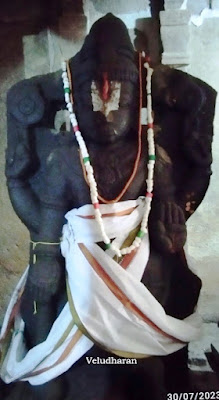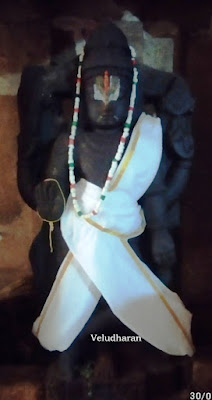The
Visit to this Thondanoor Shri Nambi Narayana
Perumal Temple, was a part of “Karnataka State, Hoysala Period Shiva and
temple’s visit”- on 30th July 2023, organised by தொண்டை மண்டல வரலாற்று ஆய்வு சங்கம் "திருக்கச்சி" FB
Group. This place is now called locally as
Thonnur.
Moolavar : Shri Nambi Narayana Perumal
Consorts : Shri Aravinda Nayaki
Some
of the salient features of this temple are…
The
temple is facing east with and entrance arch on the east side with a Garuda
thoon. Two well are on both side of the walk way. A small stepped well is
before the garuda thoon. The entrance to
the temple is on the east side with a mandapam. A dwajasthambam with a
balipeedam is in front of maha mandapam. The dwarapalakas Jayan and Vijayan are
on the entrance of the sanctum sanctorum. Moolavar Sri Narayana Perumal is about
8 feet tall with Sridevi and Bhudevi, in standing posture. Moolavar is holding
mace and flower in the upper hands and Sankha and chakra are in the lower
hands. The Sankha and Chakra are interchanged, which is an unusual feature of
Nambi Narayana Perumal. ( It was told that the interchange is to show the
victory over the Jainism ). Utsavars are in front of Moolavar. Alwars are in the
maha mandapam. There is Thiruman with sankha, Chakra and a Pada is installed
abutting the mandapam wall. ( It was told that Shri Ramanuja used to deliver
his discourse sitting on that place ).
Shri Ramanuja used to deliver his discourse sitting on this place.
Thayar
Aravinda Nayakai is in a separate temple facing east in the outer praharam.
There is a hero stone with hale kannada inscription is kept in front of Thayar
Temple ( The details will be written in
a separate post ). An eka tala vimanam is on the sanctum sanctorum.
ARCHITECTURE
The
temple prakaram wall was constructed like a fort wall. The temple consists of
sanctum sanctorum, antarala/ Sukanasi and maha mandapam. The sanctum sanctorum
is on a pada bandha adhistanam with three patta kumudam. The Pilasters are of
simple brahma kantha pilasters. The niches are empty now. A two tala nagara
vimanam is on the sanctum sanctorum. Maha nasis are on the cardinal directions.
The
antrala pillars belongs to Hoysala period lathe turned pillars and side wall
pilasters belongs to Chozha period.
Navaranga mandapa Pillars
Navaranga mandapa Pilaster - May be added at a latter period
Ceiling Panel
Bhitti / Sanctum sanctorum wall with Pilasters and Koshta
HISTORY AND INSCRIPTIONS
As per the inscriptions Moolavar was called as Sri Lakshmi Narayana and the place was called as Thondanur alias Yadava Narayana Chaturvedi mangalam.
An
instruction tablet is installed in front of the entrance mandapam. In addition
to that, 11th to 12th Century Tamil and hale kannada
Inscriptions are also found on the adhisthanam, maha mandapam walls and
Pillars. The inscription records the endowment of burning Perpetual lamps,
Naivedyam offered to the Principal deity.
Renovations
were carried out and maha samprokshanam was conducted on 19th June
2005.
Inscription No: 54 (111- 54)
This Tamil record in Tamil and Grantha characters of e. 17th
century registers the gift of 5 …. of
gold paid into the treasury by Karáradévaperumal-bhattan, of Yadavanarayana- chaturvedi-mangalam, for
maintaining a perpetual lamp to god Lakshminarayana-Perumál from out of the
interest accrued upon the endowment, It is dated the year Chitrabhanu.
Inscription No: 55 (XIV 231)
This is another Tamil inscription in Tamil and Grantha
characters of c. 14th
century, seems to record a gift of land to the Rámánujá-matha ( Mutt )
by the mahajanas. All other details the grant are lost.
Inscription
No: 56 (III - 154)
This inscription records that Vira Narasimha, the
Hoysala, granted 64 gadyānas from out of the holeya-sunka of Kuruvanka-nad, to
the mahajanas of Tondanür-agrahara for the annual repairs of the channel of
Harahu.
Inscription
No: 57 (III - 155)
This fragmentary record engraved beside No. 56
above, refers to the birds the grant of income his capital at Dorasamudra, to
which place he had returned after cockshm narayana of Yadava- Kesiyanna and
heggade… record is not clear.
Inscription
No:58 (111- 156)
This record of a 12-13th century
mentions that maha pradhana, śrikaranada-heggade Nagappa got erected a pavilion
(mantapa) probably the vahana-mantapa
Inscription
No: 59
This incomplete and fragmentary Tamil record in
Tamil and Grantha characters of a 13-14th century registers the gift
of money of 2 chinnam for food-offerings. Details are lost.
Inscription
No: 60
(XIV - 221)
This
record, a part of which is built in, belongs to the reign-period of Hoysala
Ballala-II. It is dated the year Jaya, Pushya Su. 1, Monday corresponding to
1174 CE, November 27. the week day was Wednesday. But It
registers a grant of income from pannaya, probably for the service of god
Lakshminarayana. A mahāpasayita, probably the donor, is mentioned. Details are
lost. At the end of the record there is a reference, probably to the engraver
name not clear, who was a disciple of Bhala….. This
is another inscription seems to record a gift of the grant are lost.
Inscription No: 61 (XIV ಶ್ರೀಪ 222)
This fragmentary record, in c. 12-13th century
characters, refers to a Hoysala king and to an officer who was a sarvādhikāri
and tantradhishṭhāyaka. Details are all lost.
Inscription No: 62 (XIV ಶ್ರೀಪ 223)
The purport of the fragmentary inscription records
in 12th Century Characters cannot be made out
Inscription No: 63 (XIV ಶ್ರೀಪ 223)
This inscription belonging to the reign-period of Ballála-II,
records the grant of income from tax on oil-mill driven by one of and also oil,
monthly, to god Lakshminarayana of Yadava- narayana-chaturvedimangala, by Hiriya-heggade
Machayya, heggade Kesiyanna and heggade Kommanna. The grant was made over to
Tiruvarangadasa. Machayya is described as dandadhi
Inscription No: 64 (XIV ಪ 224)
This record of Hoysala Ballala -II registers a
grant of nine vrittis of land by śrikaranada
Kaliyana of Yadavanarayana-chaturvedimangala, to god Allalaperumaludeva of Kanjiur
(Kanchipura) after purchase from Srikaranada heggade Ereyanna, who was mahapradhana,
sarvadhikäri and mahapasäyta.
It is dated the year Manmatha. Margasira su 1.
Sunday corresponding to 1175 CE, November 16.
Inscription No: 65
(XIV - 225)
The fragmentary inscription refers the rule of
Hoysala Ballala and seems to register the gift of Land. All the details are lost due to damage in the
inscription. This inscription may be assigned to 12th Century CE.
Inscription No: 66 (XIV ಶ್ರೀಪ 226)
This and Nos. 67-72 below are Tamil records in Tamil and Grantha
characters. This and Nos 67-70 below are in characters of c. 13th century
This damaged record seems to register the gift of gold to the
Viravallalan-maṇḍapa in the
temple of Lakshminarayana by an individual (name not clear) who was a reciter
of Tiruvaymolis The record refers to Gomatha.
Inscription
No: 67 (XIV ಶ್ರೀಪ 227)
This record seems to the register the sale of land
for 2 ….. to …. …. Mahajanas of the Lakshmi (narayana ) Temple, at
Yadavanarayan Chaturvedi mangalam. The details of the boundary of the land are specified.
Inscription No: 69 (XIV ಶ್ರೀಪ 229)
This registers the gift of
100 kuli at Pappalkälivayal, the sueama (seamyam) of Ariyappan. uncle of
Nagaya-dannayaka and the desa as sarvamanya by the mahajanas of Tondanür alias
Yadavanarayana-chaturvedi mangala, to god Lakshminarayana-perumal for
food-offerings.
It is dated the year Bhāva,
Aśvija śu. 2, Sunday corresponding to 1214 CE, September 7.
Inscription No: 70 (XIV 228)
This record registers a grant of 50 gadayanas for
white washing the Viravallalag mandapa in the temple of Lakshminarayana by
Tirunalayur dasar, a reviter of Tirandymoli and Ramapiran of Gomatha
Inscription No: 71 (XIV 229)
This incomplete inscription of o. 12-13th
century, is dated the year Nala,
Chittirai Sa. 13. Sunday, Atta (Hasta nakshatra. These details may correspond
to 1196 CE. April 12. But the weekday was Friday.
It seems to register the sale of hall of a site to
Annuvannan, for 5 parts, by Uttamanambi, and of the Sri aishwaras of the temple
of Lakshminarayana, for the maintenance of perpetual lamp.
Inscription No: 72 (XIV ಶ್ರೀಪ 230)
This is another incomplete epigraph of 12-13th century that
records a gift of some tiruvidaiyāṭṭam lands below the Changuttai, the tiruvidaiyāṭṭam of Lakshminarayana temple, to
Kulasekharadasar Lakshminäthan by the mahajanas of the temple of
Lakshminarayana of Tondanür alias Yadavanarayana-chaturvedimangalam.
It is dated the year Vijaya, Mithuna śu. 13, Thursday, Rohini-nakshatra.
These details do not regularly correspond in any of the years in 12-13th
century. We may probably equate it with 1173 CE, June 10, when the weekday was
Sunday.
Inscription No: 73 (XIV ಶ್ರೀವ 232)
This inscription records that the mantapa, described as olaga-sale, was
got constructed, at the instance of Hoysala Vishnuvardhana by Sarigeya Nagayya
described as mahāpradhana, ….., mahāpasayita and heggade.
Inscription No: 74 (III : XIV
ಶ್ರೀಪ 152)
This record, engraved on both sides of the slab, belongs to the
reign-period of Hoysala Vira Vallala. It registers a grant, probably of some
land, by Nilayya and Chamayya, sons respectively (?) of mahāpradhāna,
sarrädhikari, sënadhipati, mahāpasayita, dandanayaka in Achyutimayya and dandanayaka
Virayya who were in charge of protection of the Yadavagiri fort, to god
Nakharivara (? ) Tondanûr in order to provide perpetual lamp. It also records
the grant of that year's income from tax on one loom by Ayata-heggade at the
instance of Niganna.
It is dated Saumya Śrávana, su. 15, Monday. These details correspond to
1189 CE. July 29; but, the weekday was Saturday.
Inscription No: 99 (II: 64)
This is a
record engraved in Kannada on a set of fifteen copper-plates. Sanskrit and
Kannada languages are used. It gives the genealogy of the donor, Krishnaraja-II,
the king of Mysore who made a grant of two villages Yadavapura alias Thondanur
and Attikuppa in Kuruvanka-nād of Hoysala-desa, which were converted into an
agrahara. The gift was made in order that the daily rites and festivals might
be performed in the temples of Lakshminarayana and Yadava-
narayana-Vasanta-Gopala. The agrahara lands were divided into 112 erittis and
are distributed among Brahmaņas whom he invited from many countries to reside
there permanently. Details of the vrittis and names of the donees are
mentioned. The donees also received well furnished houses for their living.
Inscription mentions presiding Lakshmi Narayana Perumal
Inscription mentions presiding Lakshmi Narayana Perumal
Ref:
Epigraphia Carnatica Volume - SIX
LEGENDS
It
was told that this temple was in dilapidated condition during Shri Ramanuja’s
visit. Shri Ramanuja, along with
thondanur Nambi reconstructed this temple through Hoysala King Vishnuvardhana.
As
per the Legend, The Hoysala King Pitty Deva’s daughter was got by a spirit. The
Jain monks tried their level best to drive away, but couldn’t succeed. The
Saint Ramanuja who came to Thondanur, to escape from Kulothunga Chozha’s
order of accepting Shiva as supreme god. Saint Ramanuja drew away the spirit.
Pitty Deva as a Jain, converted himself to Vaishnavism and built 5 Narayana
Temples, as per the request of Ramanujar and this is one of them. The Saint Ramanuja was involved in
re-construction of this temple.
HOW TO REACH
This
place is 14 KM from Pandavapura railway Station, 20 KM from Srirangapatna, 69
KM from Mysore and 150 KM from Bangalore.
Nearest
Railway station is Pandavapura.
LOCATION OF THE TEMPLE : CLICK HERE
Deepa Sthambam View from front and back
A small Stepped Tank
A Hero Stone in front of Thayar sannidhi, details will be written in a separate post
---
OM SHIVAYA NAMA ---
































No comments:
Post a Comment